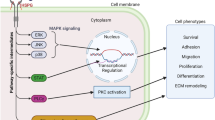Abstract
Fibrotic diseases are a significant cause of mortality. It is being increasingly appreciated that the cellular microenvironment plays a key role in promoting pathological fibrosis. A previous Bits and Bytes described an elegant series of experiments published by Bruce Riser and colleagues (Am J Pathol. 2009: 174:1725–34) that showed that CCN3 (nov) antagonizes the fibrogenic effects of CCN2.and hence could represent a novel anti-fibrotic therapy. They have continued their excellent work and have recently used the ob/ob mouse as a model of obesity and diabetic nephropathy to show that CCN3 could block the induction of profibrotic gene expression, fibrosis and loss of kidney function (Am J Pathol. 2014;184:2908–21). Also, reversal of fibrosis was observed. Thus this paper provides strong evidence that CCN3 may be used as a novel therapy to treat diabetes caused by obesity.
Similar content being viewed by others
References
Abdel Wahab N, Mason RM (2004) Connective tissue growth factor and renal diseases: some answers, more questions. Curr Opin Nephrol Hypertens 13:53–58
Batmunkh R, Nishioka Y, Aono Y, Azuma M, Kinoshita K, Kishi J, Makino H, Kishi M, Takezaki A, Sone S (2011) CCN6 as a profibrotic mediator that stimulates the proliferation of lung fibroblasts via the integrin β1/focal adhesion kinase pathway. J Med Investig 58:188–196
Blom IE, Goldschmeding R, Leask A (2002) Gene regulation of CTGF: new targets for antifibrotic therapy? Matrix Biol 21:473–482
Brigstock DR, Goldschmeding R, Katsube KI, Lam SC, Lau LF, Lyons K, Naus C, Perbal B, Riser B, Takigawa M, Yeger H (2003) Proposal for a unified CCN nomenclature. Mol Pathol 56(2):127–128
Fragiadaki M, Hill N, Hewitt R, Bou-Gharios G, Cook T, Tam FW, Domin J, Mason RM (2012) Hyperglycemia causes renal cell damage via CCN2-induced activation of the TrkA receptor: implications for diabetic nephropathy. Diabetes 61:2280–2288
Jian YC, Wang JJ, Dong S, Hu JW, Hu LJ, Yang GM, Zheng YX, Xiong WJ (2014) Wnt-induced secreted protein 1/CCN4 in liver fibrosis both in vitro and in vivo. Clin Lab 60:29–35
Königshoff M, Kramer M, Balsara N, Wilhelm J, Amarie OV, Jahn A, Rose F, Fink L, Seeger W, Schaefer L, Günther A, Eickelberg O (2009) WNT1-inducible signaling protein-1 mediates pulmonary fibrosis in mice and is upregulated in humans with idiopathic pulmonary fibrosis. J Clin Invest 119:772–787
Leask A (2009) Yin and Yang: CCN3 inhibits the pro-fibrotic effects of CCN2. J Cell Commun Signal 3:161–162
Liu S, Parapuram SK, Leask A (2013) Fibrosis caused by loss of PTEN expression in mouse fibroblasts is crucially dependent on CCN2. Arthritis Rheum 65:2940–2944
Melchior WR, Bindlish V, Jaber LA (1993) Angiotensin-converting enzyme inhibitors in diabetic nephropathy. Ann Pharmacother 27:344–350
Phanish MK, Winn SK, Dockrell ME (2010) Connective tissue growth factor-(CTGF, CCN2)–a marker, mediator and therapeutic target for renal fibrosis. Nephron Exp Nephrol 114:e83–e92
Riser BL, Najmabadi F, Perbal B, Peterson DR, Rambow JA, Riser ML, Sukowski E, Yeger H, Riser SC (2009) CCN3 (NOV) is a negative regulator of CCN2 (CTGF) and a novel endogenous inhibitor of the fibrotic pathway in an in vitro model of renal disease. Am J Pathol 174:1725–1734
Riser BL, Najmabadi F, Perbal B, Rambow JA, Riser ML, Sukowski E, Yeger H, Riser SC, Peterson DR (2010) CCN3/CCN2 regulation and the fibrosis of diabetic renal disease. J Cell Commun Signal 4:39–50
Riser BL, Najmabadi F, Garchow K, Barnes JL, Peterson DR, Sukowski EJ (2014) Treatment with the matricellular protein CCN3 blocks and/or reverses fibrosis development in obesity with diabetic nephropathy. Am J Pathol 184:2908–2921
Trojanowska M (2009) Noncanonical transforming growth factor beta signaling in scleroderma fibrosis. Curr Opin Rheumatol 21(6):623–629




